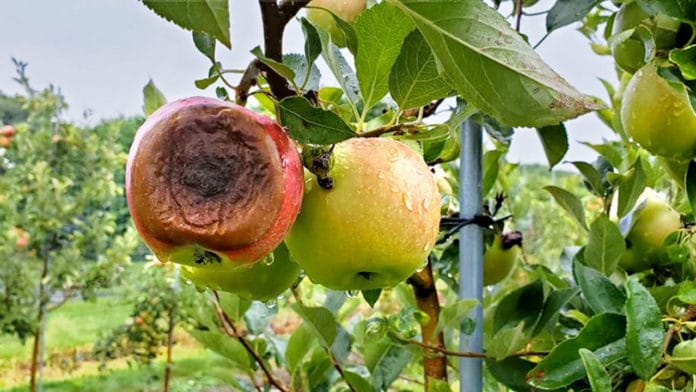Apple is vulnerable to a wide range of diseases affecting yield and fruit quality. Bitter rot, caused by Colletotrichum spp., is one of the most important fungal infections of apple, causing remarkable economic losses under wet and warm weather conditions in the U.S. and globally.
Recently, Cornell plant pathologists identified a new fungal pathogen that causes bitter rot disease in apples. They found the two species- one that has never been described before and one that has been described previously but never on this host.
Both pathogens are the family of genus Colletotrichum. They are C. acutatum species complex (CASC) and C. gloeosporioides species complex (CGSC).
The authors of the study warned that protective practices should be applied as soon as possible. If protective methods are not used promptly, apple losses from bitter rot in New York state can average up to 25% per year, with reports of some organic farms losing up to 100% of their crop. Bitter rot also accounts for up to 5% additional loss of marketable fruit in storage post-harvest.
Moreover, as per the U.S. Department of Agriculture statistics, this damage is costly for farmers; the farm gate value for New York apples was rough $260 million in 2018.
Study first author Fatemeh Khodadadi, a postdoctoral researcher in Acimovic’s lab, said, “The main purpose of the study was to identify all the Colletotrichum species in apple orchards in New York and especially in the Hudson Valley area.”
In the study, scientists isolated Colletotrichum fungi in 400 separate cultures from samples collected in commercial and private apple orchards from eight New York counties – Ulster, Dutchess, Orange, Albany, Westchester, Greene, Columbia, and Suffolk – in 2017 and 2018.
Samples came from Honeycrisp, Idared, McIntosh, Gala, Fuji, Red Delicious, Golden Delicious, Empire, Snap Dragon, Cortland, Rambo, Granny Smith, Crimson Crisp and Winesap apple cultivars that displayed typical symptoms of bitter rot disease.
Scientists also examined samples from apple orchards in Pennsylvania, where they found all three of the prevalent New York species, along with others not yet detected in New York.
Khodadadi said, “When we know which species are dominant in our area, we know how environmental conditions will affect them and which control method is best in an orchard.”
Srdjan Acimovic, a senior extension associate at the Hudson Valley Research Laboratory (part of Cornell AgriTech), said, “We think that the range of these pathogens is expanding because of global warming. However, more work needs to be done to demonstrate this.”
Scientists are further planning to collaborate with other plant pathologists and apple breeders to identify possible genes that confer natural resistance to Colletotrichum fungi that may be bred into apple cultivars.
Co-authors include collaborators from Pennsylvania State University, the Canadian Food Inspection Agency, and Louisiana State University. The work is supported by New York Apple Research and Development Program and the New York State Specialty Crop Block Grant Program.
Journal Reference:
- Khodadadi, F., González, J.B., Martin, P.L. et al. Identification and characterization of Colletotrichum species causing apple bitter rot in New York and description of C. noveboracense sp. nov. Sci Rep 10, 11043 (2020). DOI: 10.1038/s41598-020-66761-9
